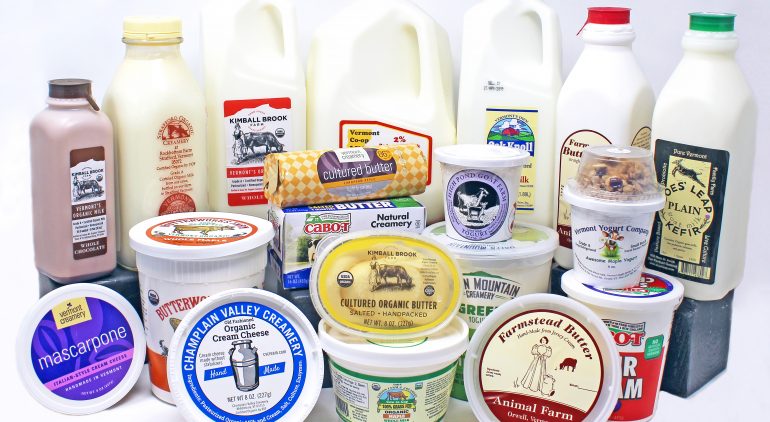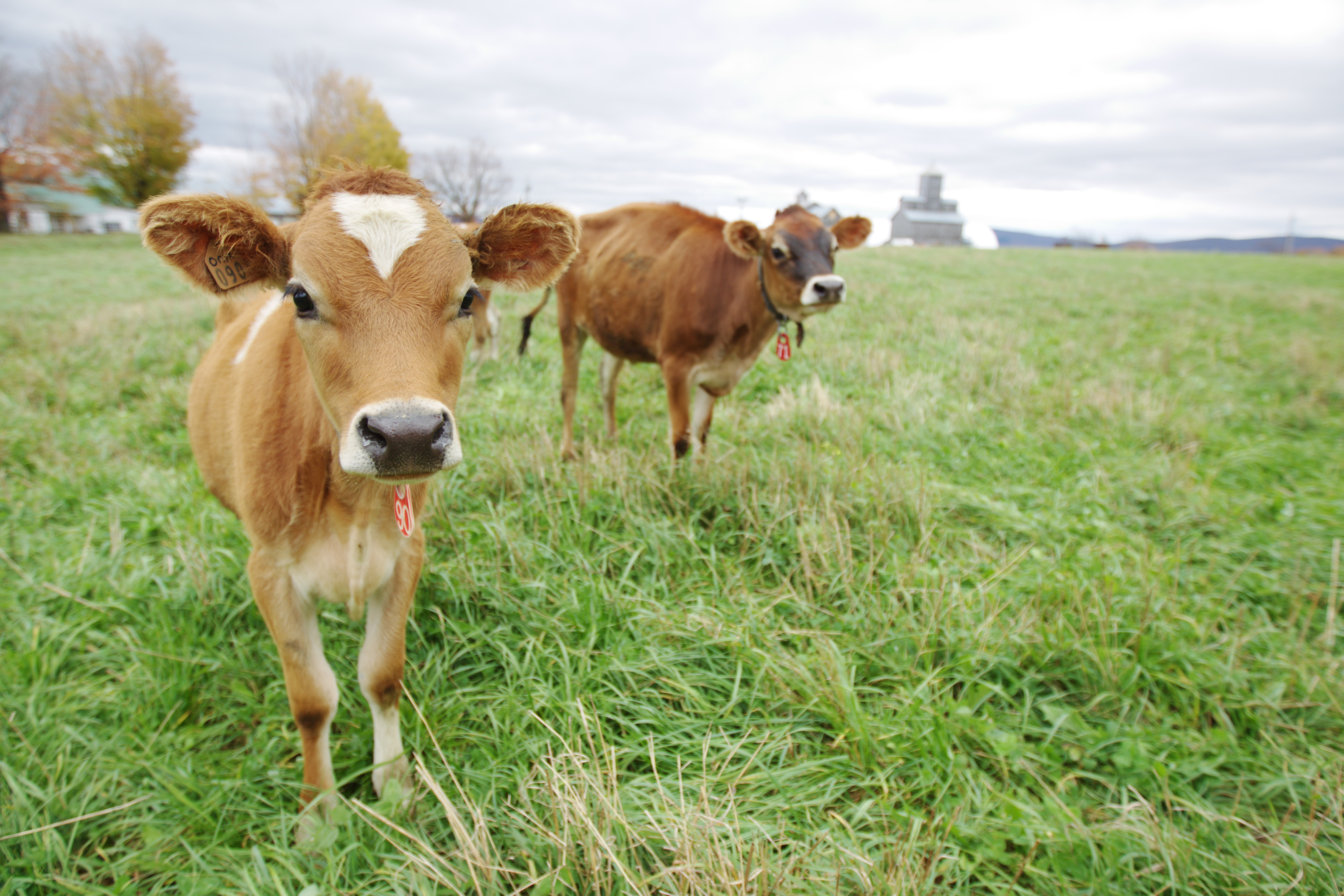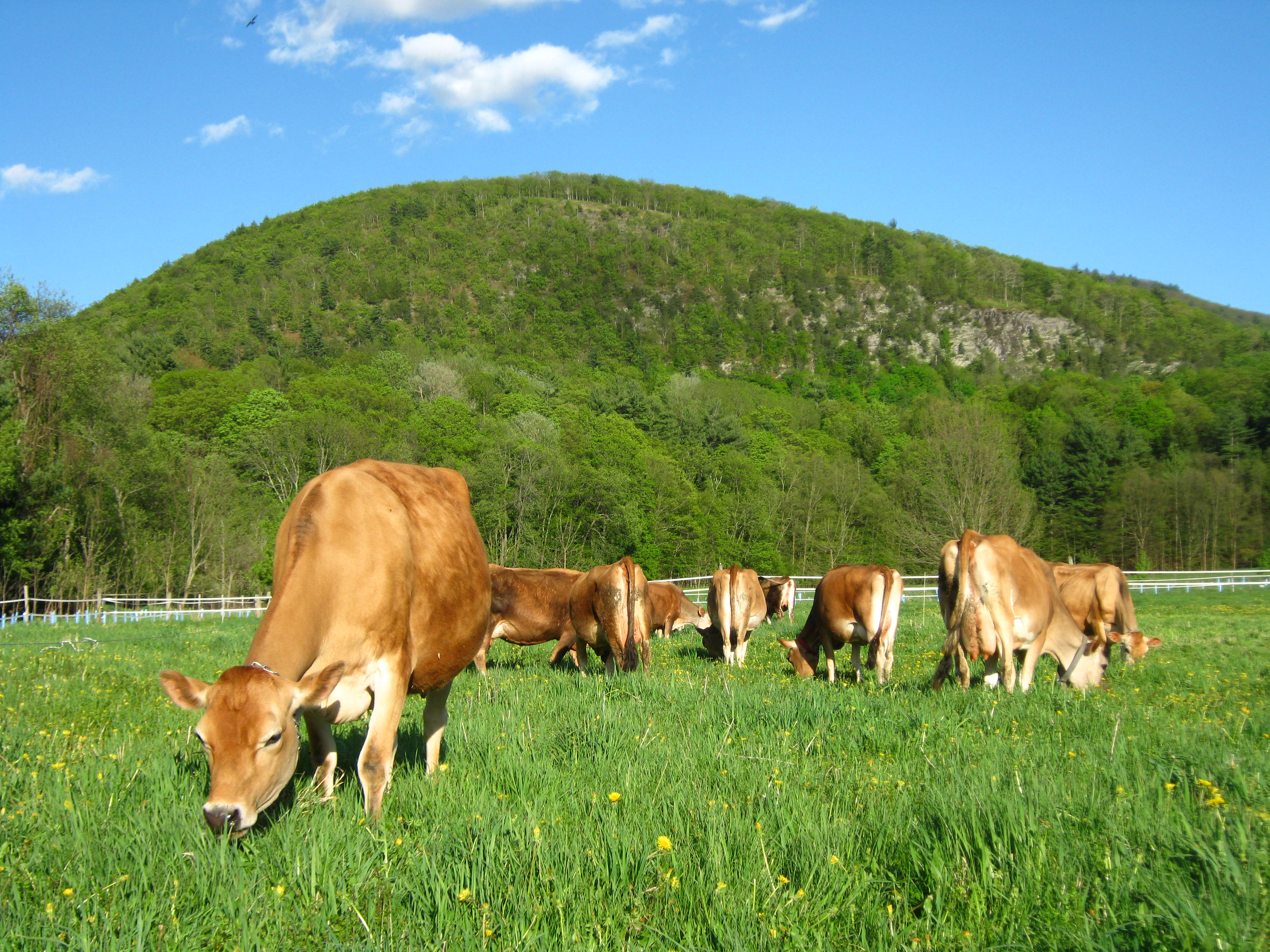
June is Dairy Month
Since 1937, Americans have been celebrating June as National Dairy Month. As we take this time to heartily celebrate our dairy farmers this month, it’s hard to avoid mention of the many challenges that dairy farmers in Vermont and across the country continue to face as they endure the fifth consecutive year of low farm-gate milk prices. This means that the price farmers are paid for the milk they produce is well below the cost of production. As a recent press release from Rural Vermont states, “our agricultural heartbeat is in threat, as is our farmland. With an average farmer age of 58 and consistently inadequate milk prices, the future for our dairy community, and its accompanying 80% of Vermont’s agricultural land is in jeopardy as it goes through a formative transition.”
The Local Scene
Our local dairy farmers need our support now more than ever, though some recent developments give us reason to feel optimistic. In April of 2019 over 50 Vermont dairy farmers and eaters gathered for a meeting geared toward developing strategies for viability. The overwhelming sentiment shared throughout the meeting was one of hope and gratitude for the local support they’re receiving. The six dairy farmers on the panel that day, along with many other conventional and organic dairy farmers in attendance, underscored the value of having strong local support. They recognized the need to provide ongoing education for the community about the impact of supporting local dairy. As George van Vlaanderen of Does’ Leap Farm in East Fairfield stated, “It’s contingent on us to educate friends and neighbors about where our food comes from and the impact of voting with your dollars. We can support a prosperous agricultural future by supporting our farmer neighbors today.” Amber Machia of Red Barn in HIghgate echoed his sentiments, reminding those in attendance that impact of spending food dollars locally extends well beyond the farms, affecting the multitude of other local businesses connected to local dairy farms, including feed supply stores, trucking companies, label and package makers, and distribution hubs.

National Support
Vermont Senator Patrick Leahy, the most senior member of the Senate Agriculture Committee, played a key role in forging the 2018 Farm Bill’s dairy priorities and, as a result of his efforts, the Farm Bill dramatically expanded support for dairy producers, providing flexible, affordable coverage options through the new Dairy Margin Coverage (DMC) program. The goal of the Farm Bill is to benefit producers of all sizes, but offers up to five times more support for the smallest farms, as those farms tend to be hardest hit during times of crisis. This is particularly good news for Vermont dairy farmers, as most manage herds of less than 200 cattle, qualifying them as small dairies by national standards. Leahy, along with Senator Debbie Stabenow (D-Mich.), Senator Roy Blunt (R-Mo.), and others, penned a bipartisan letter in April asking Agriculture Secretary Sonny Perdue to prioritize the implementation of the dairy provisions in the 2018 Farm Bill to help provide some much-needed relief to dairy farmers without delay. Leahy followed that up with an additional bipartisan letter on May 17th urging Perdue to increase trade war relief payments to a level that more accurately reflects the damages dairy farmers have faced, as the current trade mitigation program has failed to fairly compensate dairy farmers slammed by retaliatory tariffs. It sure is nice to have a local Senator fighting so hard for our farmers.
Milk with Dignity
A bright spot in local dairy news this year was the adoption of the Milk with Dignity program by local dairy giant Ben & Jerry’s. In a recent article in VT Digger, Marita Canedo, Migrant Justice staff member and event panelist representing the Milk with Dignity Program, reflected on Ben & Jerry’s adoption of the program as a human rights victory. “It took more than two years in a public campaign and 4 years in conversation. We had to have translators and it took a long time, but we finally had everyone at the same table. There are human rights in that ice cream.” The Milk with Dignity Program brings together farmers, farmworker, buyers, and consumers to ensure dignified working conditions in the dairy supply chain, asking the corporations making the most in the dairy industry to pay for a higher standard of human rights for workers.
This came as part of a larger Values-Led Dairy Vision adopted by Ben & Jerry’s, which specifies that all dairy used by Ben & Jerry’s in the manufacture of its products will be sourced from dairy farms which have:
- Thriving and dignified livelihoods for farmers and farm workers
- Exceptional animal welfare standards for cows
- A flourishing ecosystem in which feed is grown ecologically, without the use of harmful chemicals or GMOs, and in a way that protects water resources and promotes biological diversity
- Farm operations acting as a net carbon sink through minimizing greenhouse gas emissions and sequestering carbon in the soil.
Ben & Jerry’s sources most of the milk and cream from members of the St. Albans Cooperative.

Grass-fed Organic Dairy Offers Solutions
The US milk glut and the accompanying drop in dairy prices over the past few years have wielded a tough blow for conventional and organic dairy farmers alike, though organic and grass-fed dairy farms are still faring better than their conventional counterparts. Consumers are beginning to recognize the importance of supporting organic dairy production that utilizes traditional pasture-based systems of rotational grazing. Not only does this system of natural grazing aid the environment in terms of soil restoration, increased biodiversity, improved water quality, and flood mitigation – but it also it guarantees healthy lives for the animals, and they, in turn, produce meat and milk that is healthier for us than the grain-fed alternatives. Soil scientists have determined that grazing animals are critical to the process of building soil organic matter. According to Jean Paul Courtens of Roxbury Farm, who presented at the recent Real Organic Project Symposium at Dartmouth, a mere one-percent increase in the soil organic matter on the four billion acres that are used for agricultural production on our planet would allow for the sequestration of 102 billion tons of carbon dioxide. When raising livestock using managed rotational grazing, it is possible to sink more carbon than one is producing, making organic agricultural production an active part of the solution to the ongoing threat of climate change.




